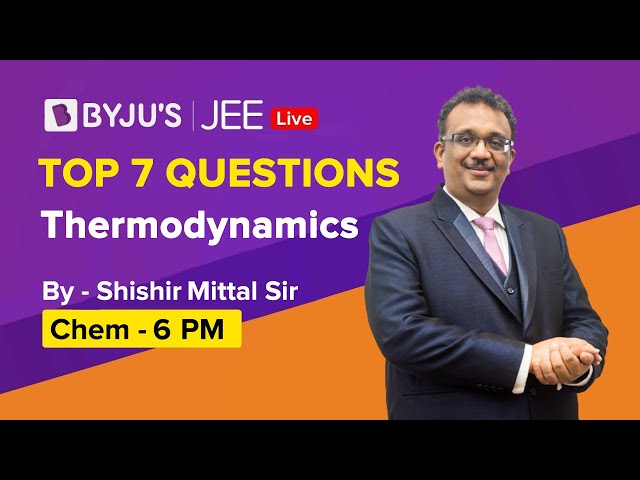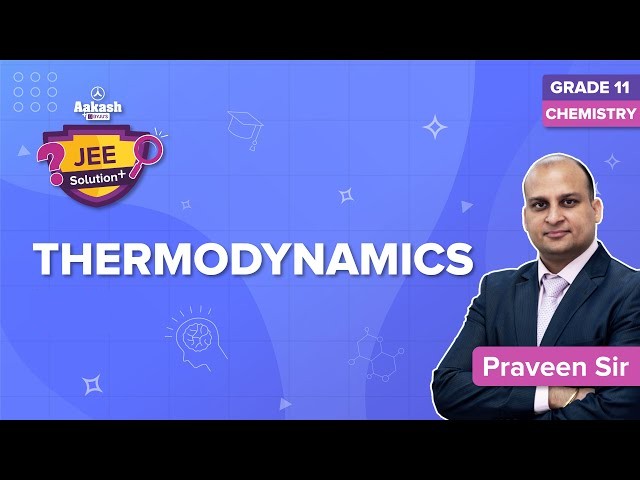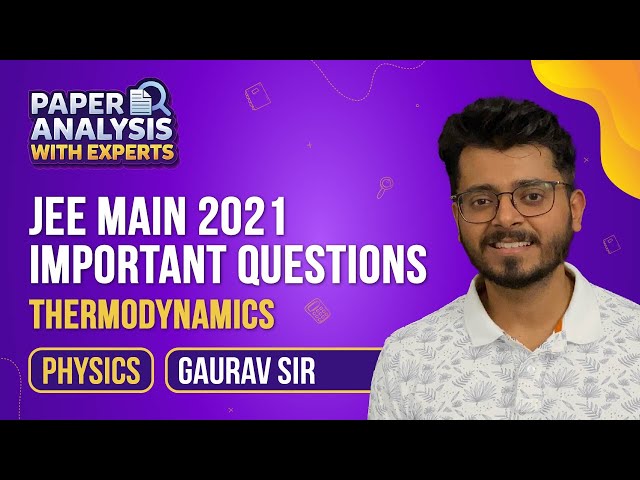Thermodynamics previous year questions and solutions are given in this article. BYJU’S provides accurate solutions created by our subject experts. The study of interaction of one body with another in terms of quantities of heat and work is known as thermodynamics. In this, the system is defined as a quantity of matter or a region in space under investigation. Everything external to the system is the environment. This article helps students to revise the previous year questions and score higher rank in the JEE exam.
As far as the JEE exam is concerned, thermodynamics is an important topic. The important topics include laws of thermodynamics, open system, closed system, isolated systems, properties of systems, entropy, Carnot cycle, Gibbs free energy, etc. The questions given here give you an idea about what type of questions to expect from this topic. Students can easily download these solutions in PDF format for free.
Download Thermodynamics Previous Year Solved Questions PDF
JEE Main Previous Year Solved Questions on Thermodynamics
1. The enthalpy change for a reaction does not depend upon the
(a) physical states of reactants and products
(b) use of different reactants for the same product
(c) nature of intermediate reaction steps
(d) difference in initial or final temperatures of involved substances.
Solution:
The enthalpy change for a reaction does not depend upon the nature of intermediate reaction steps. This is according to Hess’s law.
Hence option (c) is the answer.
2. The process with negative entropy change is
(a) dissolution of iodine in water
(b) sublimation of dry ice
(c) synthesis of ammonia from N2 and H2
(d) dissociation of CaSO4(s) to CaO(s) and SO3(g).
Solution:
N2(g) + 3H2 → 2NH3(g)
∆s = 2 – 4 = – 2 < 0
So entropy is negative.
Hence option (c) is the answer.
3. If an endothermic reaction is non-spontaneous at freezing point of water and becomes feasible at its boiling point, then
(a) ∆H is –ve, ∆S is +ve
(b) ∆H and ∆S both are +ve
(c) ∆H and ∆S both are –ve
(d) ∆H is +ve, ∆S is –ve
Solution:
∆H = +ve for endothermic reaction.
∆G = ∆H – T∆S
∆G should be positive for a non-spontaneous reaction.
So ∆G is positive at low temperatures if ∆H is positive.
∆G is negative at high temperatures if ∆S is positive.
Hence option (b) is the answer.
4. During compression of a spring, the work done is 10 kJ and 2 kJ escaped to the surrounding as heat. The change in internal energy ∆U (in kJ) is
(a) –8
(b) 12
(c) 8
(d) –12
Solution:
w = 10 kJ
q = –2 kJ
According to the first law of thermodynamics, ∆U = q + w
= –2 + 10 = 8 kJ
Hence option (c) is the answer.
5. ∆U is equal to
(a) adiabatic work
(b) isothermal work
(c) isochoric work
(d) isobaric work.
Solution:
From the first law of thermodynamics, ∆U = q + w
For adiabatic process, q = 0
So ∆U = w
Change in internal energy is equal to adiabatic work.
Hence option (a) is the answer.
6. Identify the correct statement regarding a spontaneous process:
(a) Lowering of energy in the reaction process is the only criterion for spontaneity.
(b) For a spontaneous process in an isolated system, the change in entropy is positive.
(c) Endothermic processes are never spontaneous.
(d) Exothermic processes are always spontaneous.
Solution:
In an isolated system, there is neither exchange of energy nor matter between the system and the surroundings. For a spontaneous process in an isolated system, the change in entropy is positive, i.e. S > 0. The criteria for spontaneity is the lowering of energy and the increase of entropy.
Hence option (b) is the answer.
7. The standard enthalpy of formation of NH3 is – 46 kJ mol–1. If the enthalpy of formation of H2 from its atoms is – 436 kJ mol–1 and that of N2 is –712 kJ mol–1, the average bond enthalpy of N—H bond in NH3 is
(a) – 1102 kJ mol–1
(b) – 964 kJ mol–1
(c) + 352 kJ mol–1
(d) + 1056 kJ mol–1
Solution:
½ N2 + (3/2)H2 → NH3
(∆Hf) NH3 = [½ B.E N2 + (3/2) B.E H2 – 3 B.E N-H]
-46 = [½ 712 + (3/2) 436 – 3 B.E N-H]
-46 = 356 + 654 – 3 B.E N-H
3 B.E N-H = 1056
B.E N-H = 1056/3 = 352 kJ mol–1
Hence option (c) is the answer.
8. A heat engine absorbs heat Q1 at temperature T1 and heat Q2 at temperature T2. The work done by the engine is J (Q1 + Q2). This data
(a) violates 1st law of thermodynamics
(b) violates 1st law of thermodynamics if Q1 is –ve
(c) violates 1st law of thermodynamics if Q2 is –ve
(d) does not violate the 1st law of thermodynamics.
Solution:
It does not violate the first law of thermodynamics but violates the second law of thermodynamics.
Hence option (d) is the answer.
9. If the bond dissociation energies of XY, X2 and Y2 (all diatomic molecules) are in the ratio of 1: 1: 0.5 and ∆Hf for the formation of XY is –200 kJ mol–1. The bond dissociation energy of X2 will be
(a) 100 kJ mol–1
(b) 200 kJ mol–1
(c) 800 kJ mol–1
(d) 400 kJ mol–1
Solution:
Given ∆Hf = -200 kJmol-1
Let the bond dissociation energy of XY, X2 and Y2 be x kJ mol–1, x kJ mol–1 and 0.5x kJ mol–1 respectively.
½ X2 + ½ Y2 → XY
∆Hf = sum of bond dissociation energy of all reactants – the sum of bond dissociation energy of product.
-200 = ½ ∆HX2 + ½ ∆HY2 -∆HXY
-200 = (x/2) + (0.5x/2) – x
-200 = 0.5x/2
So x = 200(2/0.5)
= 400/0.5
= 800 kJ mol-1
Hence option (c) is the answer.
10. (∆H – ∆U) for the formation of carbon monoxide (CO) from its elements at 298 K is (R = 8.314 JK–1 mol–1)
(a) –1238.78 J mol–1
(b) 1238.78 J mol–1
(c) –2477.57 J mol–1
(d) 2477.57 J mol–1
Solution:
Given T = 298
∆H – ∆U = ∆ngRT
C + ½ O2 → CO
∆ng = 1-½) = ½
∆ngRT = ½ × 8.314 × 298 = 1238.78 J mol-1
Hence option (b) is the answer.
11. An ideal gas undergoes isothermal expansion at constant pressure. During the process
(a) enthalpy increases but entropy decreases
(b) enthalpy remains constant but entropy increases
(c) enthalpy decreases but entropy increases
(d) both enthalpy and entropy remain constant.
Solution:
During isothermal expansion at constant pressure, ∆H = nCp ∆T = 0
∆S > 0
Hence option (b) is the answer.
12. The incorrect match in the following is
(a) ∆G° = 0, K = 1
(b) ∆G° < 0, K < 1
(c) ∆G° < 0, K > 1
(d) ∆G° > 0, K < 1
Solution:
∆G° = -2.303 RT log K
If ∆G° = 0, K = 1.
If ∆G° < 0, K is greater than 1.
If ∆G° > 0, K is less than 1.
Hence option (b) is the answer.
13. For a reaction, A(g) → A(l); ∆H = –3RT. The correct statement for the reaction is
(a) |∆H| < |∆U|
(b) ∆H = ∆U≠ 0
(c) |∆H| > |∆U|
(d) ∆H = ∆U = 0
Solution:
Given ∆H = –3RT
∆U = ∆H –∆ngRT
∆ng = np – nr = -1
∆U = -3RT -(-RT) = -2RT
So |∆H| > |∆U|
Hence option (c) is the answer.
14. The internal energy change when a system goes from state A to B is 40 kJ/mole. If the system goes from A to B by a reversible path and returns to state A by an irreversible path what would be the net change in internal energy?
(a) 40 kJ
(b) > 40 kJ
(c) < 40 kJ
(d) zero
Solution:
For a cyclic process, the net change in internal energy is equal to zero. The change in the internal energy does not depend on the path by which the final state is reached.
Hence option (d) is the answer.
15. In an irreversible process taking place at constant T and P and in which only pressure-volume work is being done, the change in Gibbs free energy (dG) and change in entropy (dS), satisfy the criteria
(a) (dS)V, E < 0, (dG)T, P < 0
(b) (dS)V, E > 0, (dG)T, P < 0
(c) (dS)V, E = 0, (dG)T, P = 0
(d) (dS)V, E = 0, (dG)T, P > 0
Solution:
For spontaneity, change in entropy (dS) must be positive i.e., greater than zero. Change in Gibbs free energy (dG) must be negative. i.e less than zero. (dS)V, E > 0, (dG)T, P < 0.
Hence option (b) is the answer.
Also Read:- Thermodynamics
Thermodynamics Important Topics

Thermodynamics Important Questions

Thermodynamics Top 7 Questions

Thermodynamics JEE Solutions

Thermodynamics JEE Main Important Questions


Comments